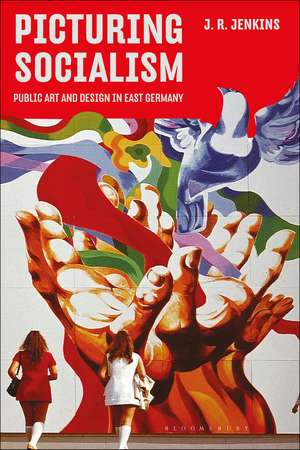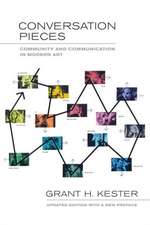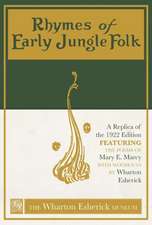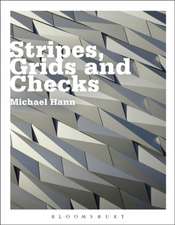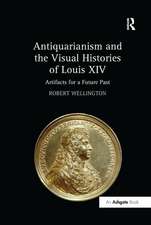Picturing Socialism: Public Art and Design in East Germany
Autor J. R. Jenkinsen Limba Engleză Hardback – 24 feb 2021
Preț: 566.54 lei
Preț vechi: 814.62 lei
-30% Nou
Puncte Express: 850
Preț estimativ în valută:
108.41€ • 112.46$ • 90.40£
108.41€ • 112.46$ • 90.40£
Carte disponibilă
Livrare economică 06-20 martie
Preluare comenzi: 021 569.72.76
Specificații
ISBN-13: 9781350067141
ISBN-10: 1350067148
Pagini: 264
Ilustrații: 58 bw illus and 8pp colour plate section
Dimensiuni: 156 x 234 mm
Greutate: 0.37 kg
Editura: Bloomsbury Publishing
Colecția Bloomsbury Visual Arts
Locul publicării:London, United Kingdom
ISBN-10: 1350067148
Pagini: 264
Ilustrații: 58 bw illus and 8pp colour plate section
Dimensiuni: 156 x 234 mm
Greutate: 0.37 kg
Editura: Bloomsbury Publishing
Colecția Bloomsbury Visual Arts
Locul publicării:London, United Kingdom
Caracteristici
Tackles several popular stereotypes and presents an original viewpoint on socialist art and architecture
Notă biografică
J.R. Jenkins is a design historian and writer on graphic design and teaches design contexts at Falmouth University, UK.
Cuprins
List of FiguresList of PlatesPrefaceAcknowledgementsGlossary and AbbreviationsIntroductionPart One: Reconstruction, Art and Ornament (1945 to 1963)1. Modernism, Realism and Muralism - the Struggle for Art in Post-fascist Germany2. The Synthesis of Art and Architecture During the Transition to Industrialized BuildingPart Two: Developing a Realist Modernism (1959 to 1973)3. Reconceptualizing the Place of Art in the System-built Environment4. New Socialist Landscapes and the Building of Halle-Neustadt 5. Innovations in Socialist Public Art in Halle-NeustadtPart Three: From the Monumental to the Unreal (1973-1990)6. A Space of Pure Possibility: The X. Weltfestspiele and its Impact on Public Art7. 'Ultimately, Ordinary People Want to Have a Bit of Kitsch': How Socialist Realism Looked UnrealConclusionSelect Bibliography List of IntervieweesIndex
Recenzii
In this lavishly illustrated account J. R. Jenkins shows how public art, craft, design and architecture became key elements in the socialist imaginary. Picturing Socialism takes the reader on a fascinating journey through the former East Germany: from steel and coal cities, to science and technology centres and ports. Containing an extraordinary visual record of many rapidly vanishing works of art, the book draws on fascinating interviews and contemporary debates. Picturing Socialism is an important and timely addition to studies of Cold War history and politics.
J. R. Jenkins' Picturing Socialism explores the placement and legacy of public art in the GDR from post-war re-construction through to the 1990s. Spanning the mid-century to the late modern, Jenkins deftly surveys and evaluates the forms, functions and evolving ideological imperatives which drove these very public genres. Cogently authored and contextualized, this well illustrated and incisively researched publication looks set to become a benchmark intervention in the emerging history of the GDR's public art and design aesthetic.
Picturing Socialism fills a gap in twentieth-century design history by focusing on how socialist realism in East Germany used urban places as a canvas to depict communal values. For those interested in the graphic image of the twenty-first century city, this book provides valuable insight into the emergence of Complex Environmental Design in the former German Democratic Republic.
An enlightening analysis of the complex relation between socialist politics and the steelworker reliefs, farm girl paintings, cosmonaut mosaics, dandelion-shaped sprinklers and other artwork adorning East German buildings
J. R. Jenkins presents a magnificent study: this well-informed and intelligent book reconstructs the strategic importance of architecture-related art in shaping the built environment of the GDR. For the three historical phases of development - Reconstruction 1949-1963, Socialist Modernism 1959-1973 and the transition to Postmodernism 1973-1990 - she uses exemplary works of art to trace both the changing building tasks and the relationships between clients, architects and artists, as well as the conceptual background of their respective interactions. The author's double perspective - as a student in Berlin in 1990, she witnessed the disappearance and general devaluation of East German art in the public consciousness, now as an academic she observes the new international appreciation of the aesthetic culture of socialism - saves her from the old Cold War concept of Western modernism and conveys this unique cultural heritage to us anew with regard to a decolonised, gendered and globalised modernism.
J. R. Jenkins' Picturing Socialism explores the placement and legacy of public art in the GDR from post-war re-construction through to the 1990s. Spanning the mid-century to the late modern, Jenkins deftly surveys and evaluates the forms, functions and evolving ideological imperatives which drove these very public genres. Cogently authored and contextualized, this well illustrated and incisively researched publication looks set to become a benchmark intervention in the emerging history of the GDR's public art and design aesthetic.
Picturing Socialism fills a gap in twentieth-century design history by focusing on how socialist realism in East Germany used urban places as a canvas to depict communal values. For those interested in the graphic image of the twenty-first century city, this book provides valuable insight into the emergence of Complex Environmental Design in the former German Democratic Republic.
An enlightening analysis of the complex relation between socialist politics and the steelworker reliefs, farm girl paintings, cosmonaut mosaics, dandelion-shaped sprinklers and other artwork adorning East German buildings
J. R. Jenkins presents a magnificent study: this well-informed and intelligent book reconstructs the strategic importance of architecture-related art in shaping the built environment of the GDR. For the three historical phases of development - Reconstruction 1949-1963, Socialist Modernism 1959-1973 and the transition to Postmodernism 1973-1990 - she uses exemplary works of art to trace both the changing building tasks and the relationships between clients, architects and artists, as well as the conceptual background of their respective interactions. The author's double perspective - as a student in Berlin in 1990, she witnessed the disappearance and general devaluation of East German art in the public consciousness, now as an academic she observes the new international appreciation of the aesthetic culture of socialism - saves her from the old Cold War concept of Western modernism and conveys this unique cultural heritage to us anew with regard to a decolonised, gendered and globalised modernism.
